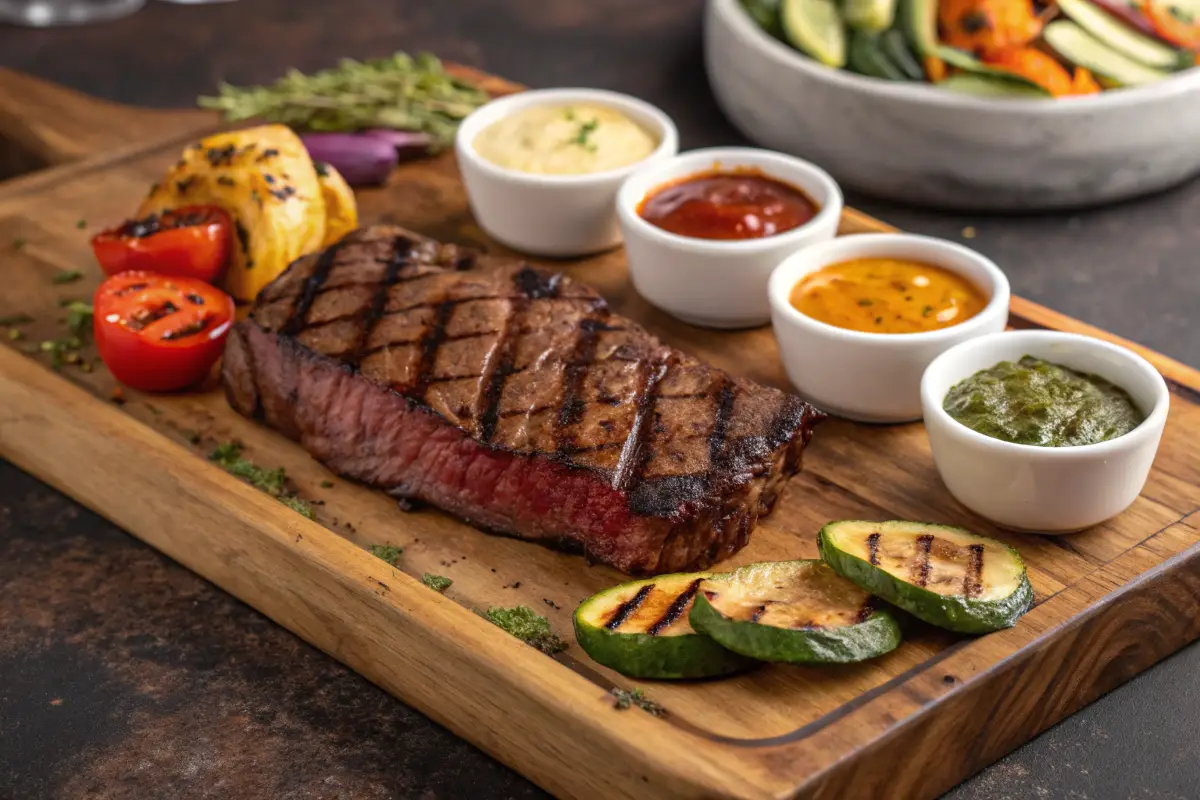Introduction of Denver Steak
Have you ever tried the Denver steak, one of the most underrated and delicious cuts of beef? Despite being lesser-known, the Denver steak offers a tender, juicy texture and rich marbling, making it a favorite among chefs and meat lovers alike. Surprisingly, this flavorful cut comes from the chuck portion of the cow, an area often associated with tougher meat. However, when cooked the right way, Denver steak transforms into a melt-in-your-mouth masterpiece. If you’re looking for a steak that balances affordability, flavor, and versatility, the Denver steak is your perfect match.
What makes the Denver steak stand out, you might wonder? For starters, it’s not only easy to cook but also incredibly versatile. Whether you prefer it grilled, pan-seared, or sous vide, the Denver steak delivers a buttery, rich taste every single time. Plus, it pairs beautifully with a variety of sides, sauces, and garnishes, ensuring that it suits every occasion, from casual dinners to elegant gatherings.
In this article, we’ll dive into everything you need to know about Denver steak. We’ll explore its history, explain how to select the best cut, and provide foolproof cooking tips. Along the way, we’ll also share creative variations, serving suggestions, and nutritional benefits. So, if you’re curious about how to unlock the full potential of this hidden gem, you’re in the right place. Let’s uncover the secrets of the Denver steak and learn how to make it the star of your next meal!
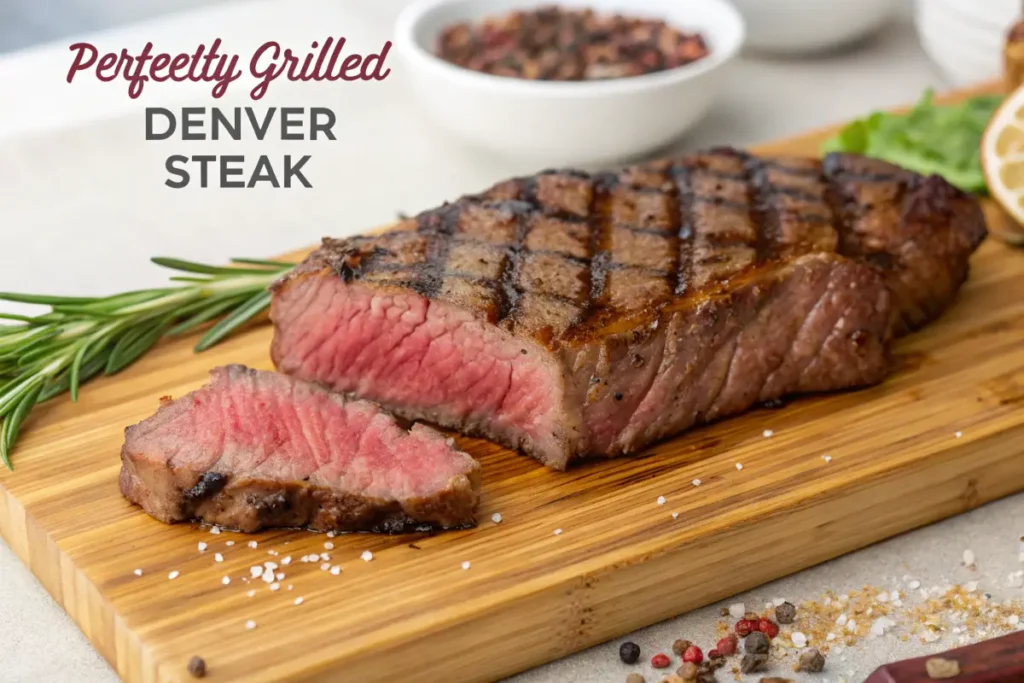
Table of contents
- Introduction of Denver Steak
- History and Origins of Denver Steak
- Ingredients You Need for the Perfect Denver Steak
- Step-by-Step Denver Steak Recipe: Perfectly Cooked Every Time
- The Top 5 Tips for Cooking Denver Steak Like a Pro
- Variations and Serving Suggestions for Denver Steak
- Nutritional Analysis of Denver Steak
- Frequently Asked Questions About Denver Steak
- Conclusion: Why Denver Steak Deserves a Place on Your Plate
History and Origins of Denver Steak
Did you know that the Denver steak is a relatively modern discovery in the world of beef cuts? Unlike more traditional cuts like ribeye or sirloin, the Denver steak was identified in the early 2000s as part of a research project conducted by the Beef Checkoff Program. This initiative aimed to find new, affordable cuts of beef that were both tender and flavorful. Interestingly, the Denver steak comes from the chuck primal, a section of the cow traditionally associated with tougher cuts.
What’s even more fascinating is how this cut got its name. While its exact origin is unclear, many believe it was named after the city of Denver to evoke feelings of hearty, all-American dining. Despite being a lesser-known cut at first, it quickly gained popularity among chefs and home cooks for its exceptional marbling and tenderness.
Today, the Denver steak is celebrated as one of the best “hidden gem” cuts of beef. Thanks to its rich flavor and affordability, it’s a fantastic choice for anyone looking to enjoy restaurant-quality steak at home.
Ingredients You Need for the Perfect Denver Steak
Creating a mouthwatering Denver steak starts with the right ingredients. Each element plays an essential role in enhancing the flavors and textures of this tender, marbled cut. With the perfect combination of seasonings and sides, you’ll take your steak to the next level. Let’s take a look at what you’ll need to get started.
Gather Your Ingredients and Tools
Before you begin, make sure you have everything you need. For this recipe, you’ll need:
- 2 Denver steaks (1-1.5 inches thick)
- 2 teaspoons kosher salt
- 1 teaspoon freshly cracked black pepper
- 1 teaspoon garlic powder (optional)
- 1 tablespoon avocado oil (or any high-smoke-point oil)
- 2 tablespoons unsalted butter
- 2 sprigs fresh rosemary or thyme (optional)
- 2 garlic cloves, crushed (optional)
You’ll also need a cast iron skillet (or grill), tongs, a meat thermometer, and aluminum foil.
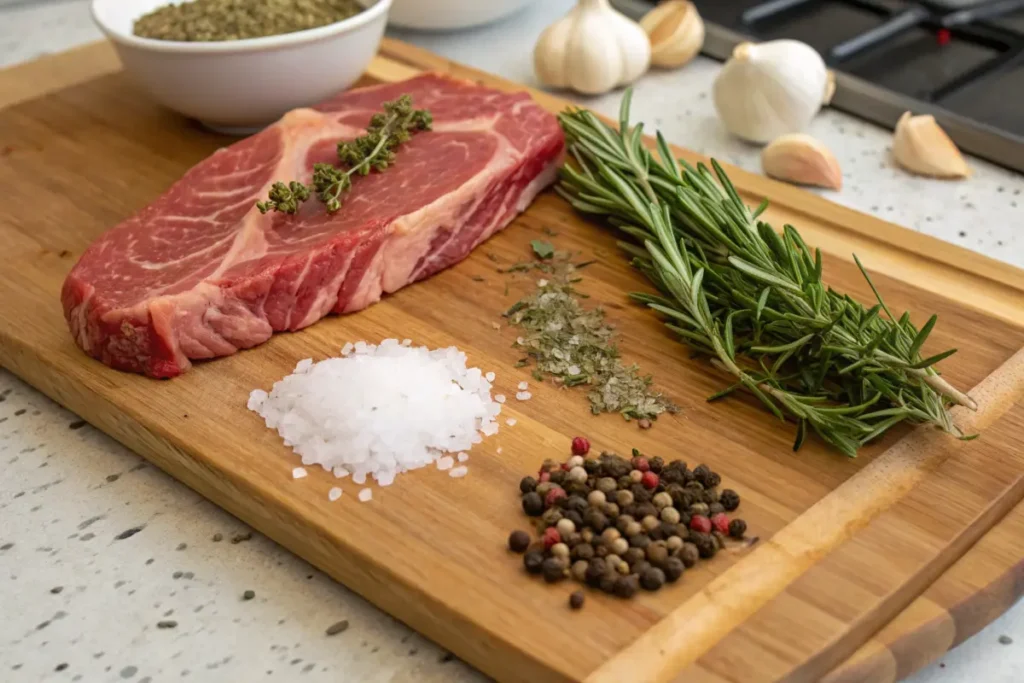
Why These Ingredients Work Perfectly Together
To start, Denver steak has incredible natural flavor, so simple seasonings like kosher salt and black pepper allow its marbling to shine through. Meanwhile, garlic powder and fresh herbs such as rosemary or thyme provide a subtle boost to the steak’s aroma and taste. Adding avocado oil ensures a perfect sear every time, while a final pat of butter creates that melt-in-your-mouth finish we all crave.
Additionally, if you want to elevate your steak even further, try serving it with a side of roasted vegetables, mashed potatoes, or a fresh salad. These sides complement the bold flavors of Denver steak without overpowering it.
By carefully selecting these ingredients, you’ll be able to highlight the natural tenderness and rich marbling of the Denver steak in every bite.
Optional Side Ingredients for Pairing
If you’re looking to round out your Denver steak meal, consider adding these classic sides:
- Garlic Mashed Potatoes: Creamy and buttery, perfect for soaking up steak juices.
- Roasted Asparagus or Brussels Sprouts: These vegetables add a fresh, slightly charred flavor to balance the richness.
- Arugula Salad with Lemon Vinaigrette: Light and tangy, this pairs wonderfully with the boldness of the Denver steak.
Each of these ingredients and sides works together to make your Denver steak meal a showstopper. By using the freshest ingredients and the perfect balance of flavors, you’ll create a dish that is as delicious as it is memorable.
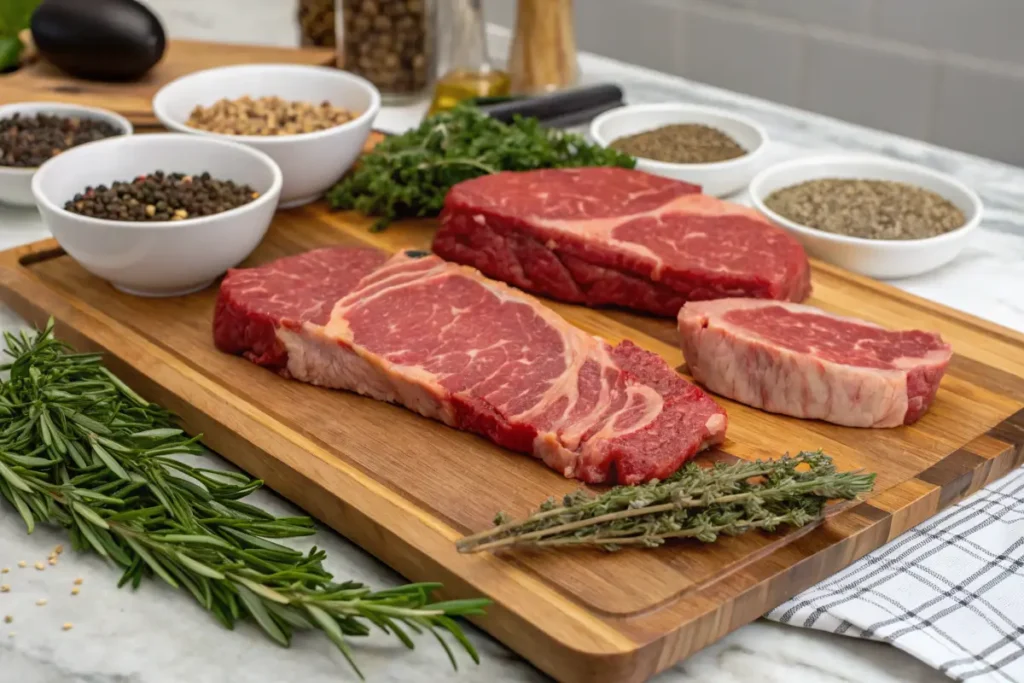
Step-by-Step Denver Steak Recipe: Perfectly Cooked Every Time
Preparing Denver steak doesn’t have to be complicated. By following these simple, step-by-step instructions, you’ll achieve a tender, flavorful steak with a golden crust and juicy center. Let’s dive into the recipe to help you cook Denver steak like a pro!
Prepare the Steaks
Start by removing the Denver steaks from the refrigerator at least 30 minutes before cooking. Letting them rest at room temperature ensures even cooking.
Next, pat the steaks dry with paper towels. This step is crucial for achieving a perfect sear. Once the steaks are dry, generously season both sides with kosher salt and freshly cracked black pepper. If you’d like to add more depth, sprinkle a pinch of garlic powder or smoked paprika. Let the seasoning absorb into the meat while you heat your skillet.
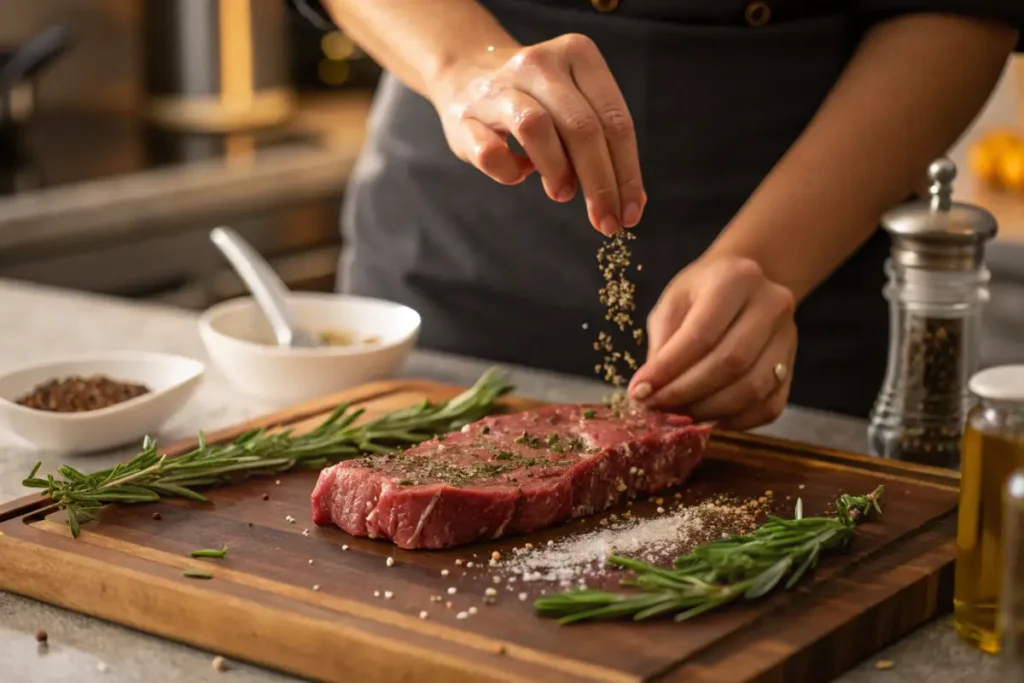
Heat Your Cooking Surface
Place a cast iron skillet on the stove and heat it over medium-high heat. Add 1 tablespoon of avocado oil and let it heat until it begins to shimmer. If you’re grilling, preheat the grill to high and brush the grates with oil to prevent sticking. This step is essential for creating a golden crust on your steak.
Sear the Steaks
Carefully place the steaks into the hot skillet or grill. Lay them away from you to avoid oil splatter. Let the steaks sear undisturbed for 2-3 minutes on one side. This allows the steak to develop a deep, caramelized crust.
Flip the steaks using tongs and sear the other side for another 2-3 minutes. If you’re using fresh rosemary, thyme, or garlic, add them to the pan during the final minute of searing. The herbs and garlic will infuse the steaks with subtle, aromatic flavors.
Check for Doneness
Using a meat thermometer, check the internal temperature of the steaks to ensure they’re cooked to your desired doneness:
- Rare: 120-125°F (49-52°C)
- Medium-Rare: 130-135°F (54-57°C)
- Medium: 140-145°F (60-63°C)
If the steaks need more time, reduce the heat to medium and cook for an additional 1-2 minutes per side. For thicker cuts, you can transfer the skillet to a preheated oven at 400°F (204°C) to finish cooking evenly.
Rest the Steaks
Once the steaks reach your desired doneness, remove them from the skillet and place them on a cutting board. Tent them loosely with aluminum foil and let them rest for 5-7 minutes. This step is crucial because it allows the juices to redistribute throughout the meat, ensuring every bite is tender and flavorful.
Slice and Serve
Finally, use a sharp knife to slice the steaks against the grain into thin strips. This technique shortens the muscle fibers and makes the steak easier to chew. Serve your perfectly cooked Denver steak with your favorite sides, such as roasted vegetables, mashed potatoes, or a fresh salad. For an extra burst of flavor, drizzle the steak with garlic butter or chimichurri sauce.
Pro Tips for Success
- Always pat the steaks dry before seasoning to achieve a better sear.
- Use a meat thermometer to avoid overcooking your steak.
- For the best flavor, let the steaks rest after cooking—it makes a big difference in tenderness.
The Top 5 Tips for Cooking Denver Steak Like a Pro
Cooking Denver steak to perfection requires both technique and attention to detail. With its tender texture and rich marbling, this cut is incredibly rewarding when handled properly. To help you elevate your steak game, here are the top 5 tips for cooking Denver steak like a professional chef. Follow these tips step by step, and your steak will turn out juicy, flavorful, and downright irresistible
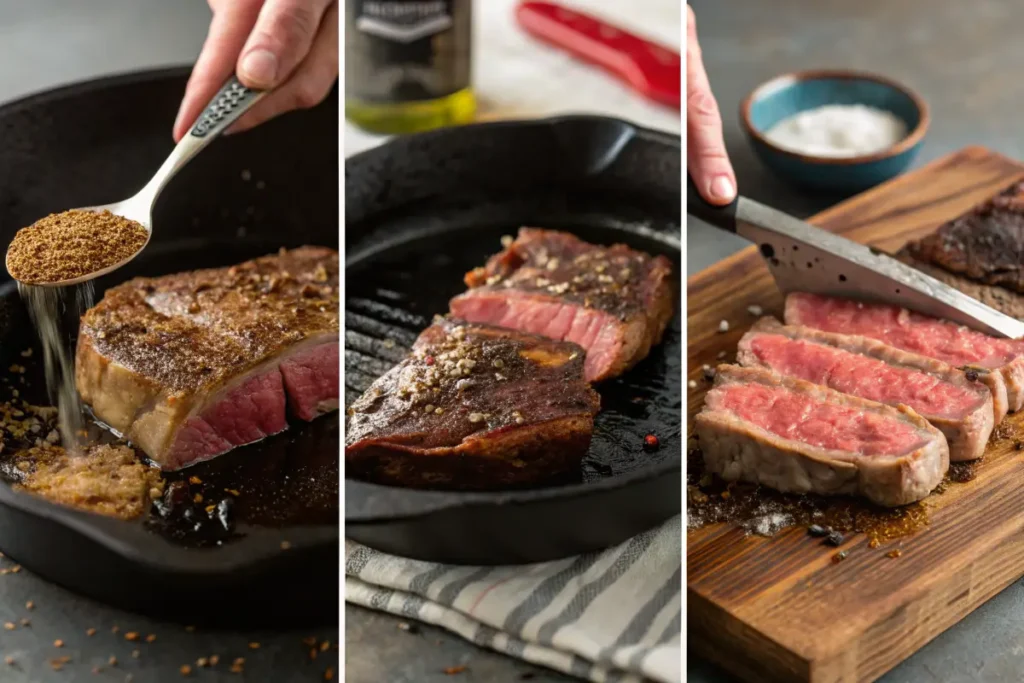
Choose High-Quality Denver Steak
The foundation of a great steak starts with the quality of the cut itself. Always select fresh Denver steaks with visible marbling throughout, as this fat contributes to the steak’s tenderness and flavor. If possible, buy your steak from a local butcher, who can guide you toward the best options. While pre-packaged steaks can work in a pinch, freshly cut steaks tend to deliver better results. Remember, choosing a steak that is at least 1 inch thick ensures more even cooking.
Season Generously and Early
To bring out the natural flavor of Denver steak, seasoning is crucial. Generously coat the steak with kosher salt and freshly cracked black pepper. If you want to add more depth, sprinkle a bit of garlic powder or smoked paprika. For the best results, season the steak at least 30 minutes before cooking. This allows the salt to penetrate the meat, which not only enhances the flavor but also tenderizes the steak.
Moreover, don’t forget to pat the steak dry with paper towels before seasoning. Removing excess moisture ensures a better sear, which is essential for locking in the juices. Transitioning to seasoning after drying helps create the perfect crust during cooking.
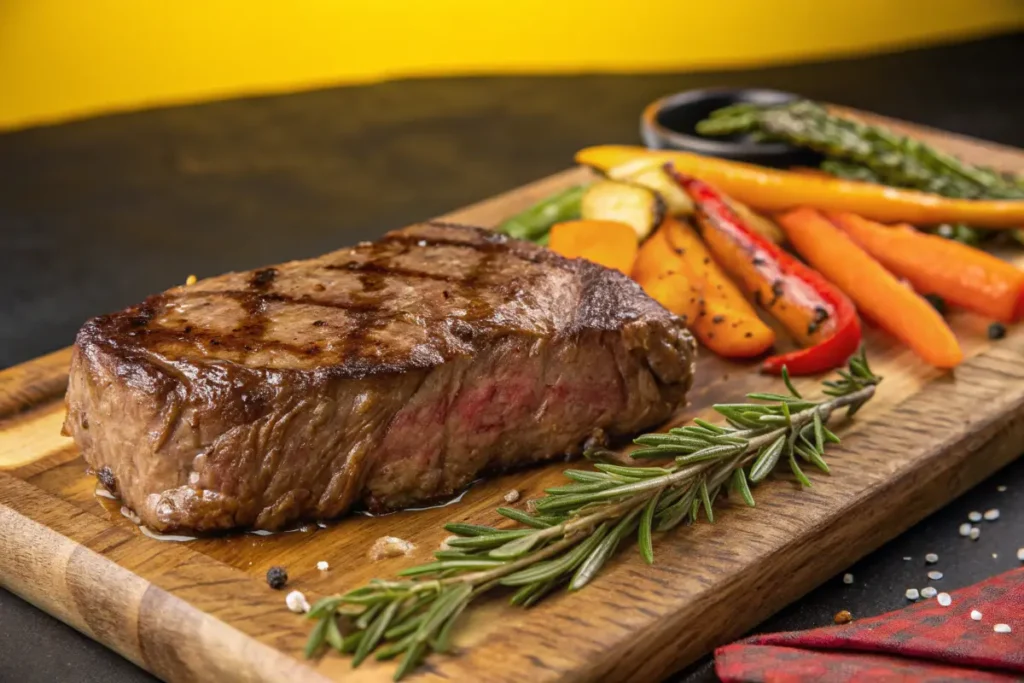
Use High Heat for Searing
A professional-level steak is all about achieving the perfect sear. To do this, always use high heat, whether you’re cooking on a cast iron skillet or grilling. Start by preheating your pan or grill for a few minutes to ensure it’s hot enough. Then, add a tablespoon of high-smoke-point oil like avocado oil or grapeseed oil. Once the oil begins shimmering, place the steak in the pan or on the grill.
Let the steak cook undisturbed for 2-3 minutes per side. This step is crucial because it creates the golden crust that seals in the steak’s natural juices. To elevate the flavor further, toss in a few fresh rosemary or thyme sprigs and crushed garlic cloves toward the end of searing. As the herbs and garlic release their aromas, they infuse the steak with subtle, complementary notes.
Cook to Your Desired Doneness
Getting the perfect doneness is often the trickiest part of cooking steak, but it’s manageable with a meat thermometer. For a medium-rare Denver steak, aim for an internal temperature of 130-135°F (54-57°C). If you prefer medium, cook the steak to 140-145°F (60-63°C). Always check the temperature at the thickest part of the steak for the most accurate reading.
If the steak is thicker, you can transition from stovetop to oven to finish cooking evenly. Preheat the oven to 400°F (204°C), and after searing, transfer the steak to the oven for 5-7 minutes. This method prevents the outside from overcooking while the inside reaches the perfect doneness.
Let It Rest Before Slicing
One of the most important yet overlooked steps is allowing the steak to rest. After cooking, remove the Denver steak from the heat and place it on a cutting board. Tent it loosely with aluminum foil and let it rest for 5-7 minutes. During this time, the juices redistribute throughout the steak, ensuring each bite is as juicy and tender as possible.
When it’s time to slice, always cut against the grain. This shortens the muscle fibers and makes the steak easier to chew. Skipping this step can result in a tougher texture, so don’t rush the resting process.
Bonus Tips for Success
- Don’t Overcrowd the Pan: Cooking one or two steaks at a time allows for better heat distribution and ensures a proper sear.
- Adjust Heat as Needed: If your steak is browning too quickly, lower the heat slightly to avoid burning.
- Finish with Butter: Adding a pat of butter at the end creates a glossy finish and enhances the steak’s richness.
By following these top 5 tips, you’ll be cooking Denver steak like a pro in no time. Whether you’re grilling, pan-searing, or using a combination of methods, these tips ensure that every bite is tender, juicy, and full of flavor.
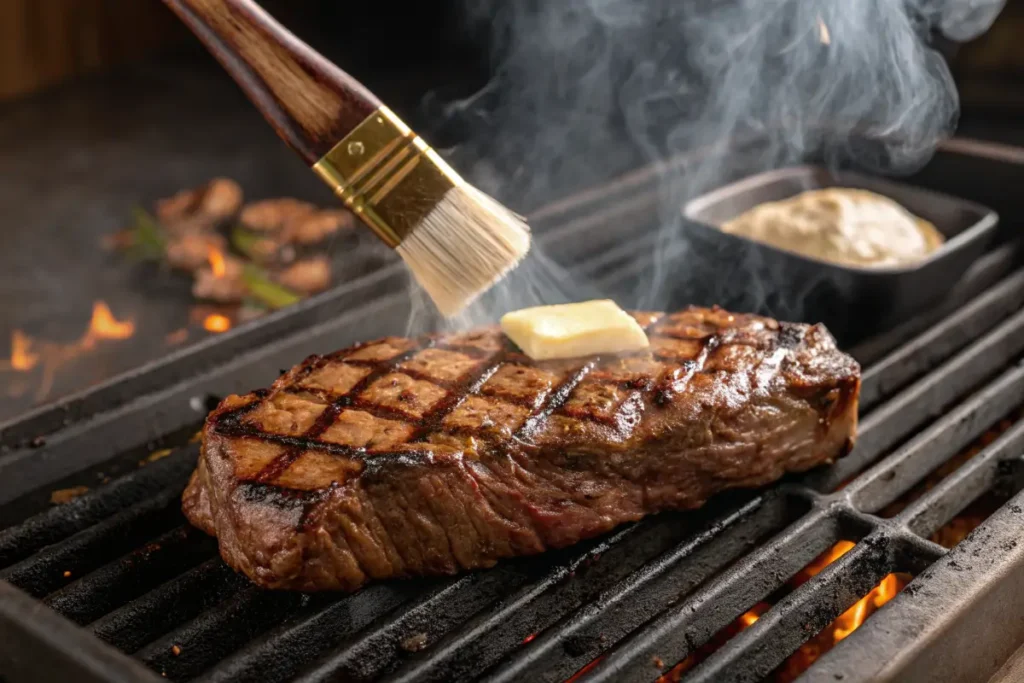
Variations and Serving Suggestions for Denver Steak
Denver steak is versatile, making it easy to customize based on your taste or the occasion. From bold marinades to creative sides, there are plenty of ways to enjoy this flavorful cut. Here are some simple ideas to elevate your meal.
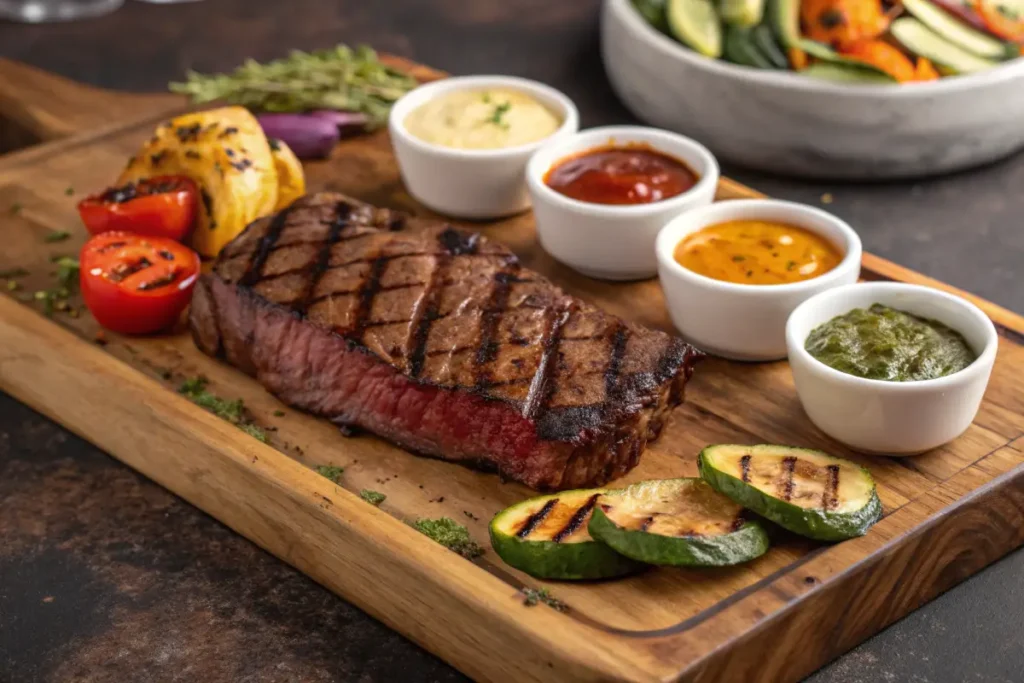
Flavorful Variations
- Classic Steakhouse Style: Season the steak with salt and pepper, then finish with garlic butter. Serve it with mashed potatoes and roasted vegetables for a comforting, timeless dish.
- Spicy Kick: Rub the steak with cayenne, paprika, and garlic powder. Pair it with coleslaw and sweet potato fries for a balanced, bold flavor.
- Asian-Inspired Twist: Marinate the steak in soy sauce, ginger, and honey. Slice it thin and serve over rice or stir-fried veggies for a fresh and zesty option.
Serving Suggestions
- Elegant Plating: Slice the steak thin and fan it out on a plate. Add roasted vegetables and drizzle with balsamic glaze for a sophisticated look.
- Tacos: Use thin steak slices in warm tortillas. Top with guacamole, pickled onions, and a squeeze of lime for a fun and casual meal.
- Steak Salad: Serve the steak over mixed greens with cherry tomatoes, cucumbers, and vinaigrette for a light, refreshing option.
No matter how you serve it, Denver steak always delivers bold flavors and tender bites.
Nutritional Analysis of Denver Steak
Denver steak isn’t just a delicious cut of beef—it’s also loaded with important nutrients that make it a smart choice for your meals. While the rich marbling provides incredible flavor, it also delivers essential vitamins and minerals to support your health. Whether you’re searching for a protein-packed meal or a nutrient-dense option to fuel your body, Denver steak offers a perfect balance of taste and nutrition.
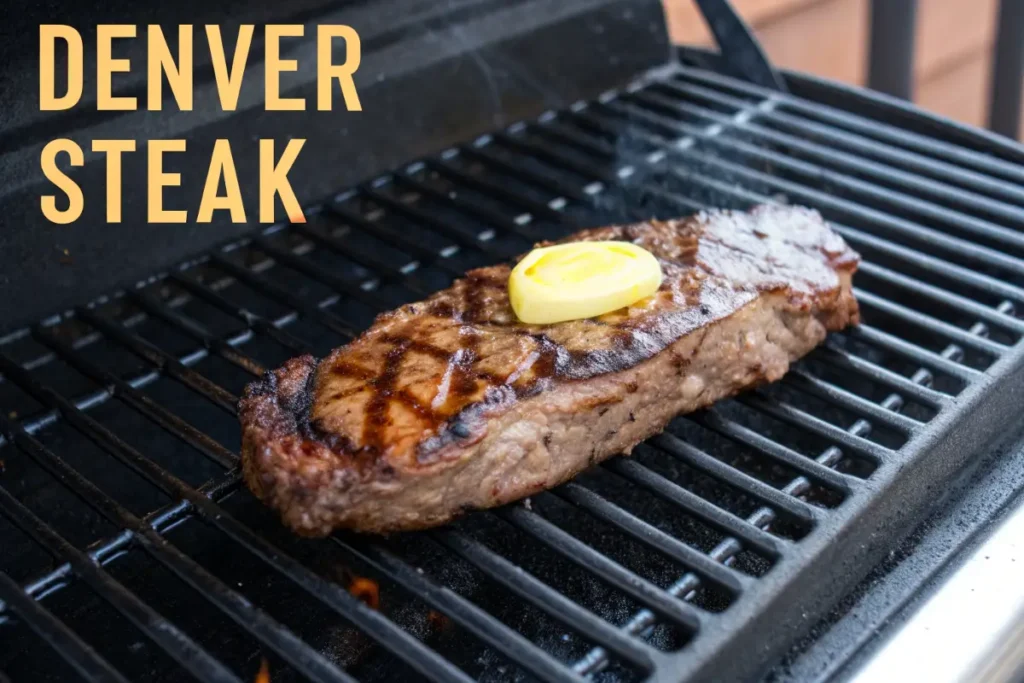
Nutritional Breakdown (Per 6-Ounce Serving)
| Nutrient | Amount | Why It’s Important |
|---|---|---|
| Calories | 350-400 kcal | Provides the energy you need to stay active and alert throughout the day. |
| Protein | 35-40 grams | Helps repair muscles and keeps you feeling full and satisfied for longer periods. |
| Fat | 22-28 grams | Adds flavor and supports satiety, especially in moderation. |
| Saturated Fat | 9-11 grams | Plays a role in brain function and hormone production when consumed moderately. |
| Iron | 3.5-4 mg | Boosts oxygen transportation in your bloodstream, which reduces fatigue. |
| Zinc | 5-6 mg | Strengthens your immune system while promoting skin health and healing. |
| B Vitamins | High amounts | Aids in energy production and supports your nervous system for better focus. |
Why Denver Steak Is a Great Choice
To begin with, Denver steak is an excellent source of protein, which is crucial for muscle repair and maintenance. Additionally, it provides high levels of iron, a mineral that helps combat fatigue by improving oxygen delivery throughout your body. Furthermore, the generous amounts of B vitamins in Denver steak boost energy levels and support brain health, making it an ideal choice for anyone with an active lifestyle.
In addition to its nutritional value, Denver steak is versatile and works well with a variety of sides. For instance, pairing it with roasted vegetables or a fresh green salad helps create a balanced meal. Alternatively, if you’re following a low-carb or ketogenic diet, consider serving it alongside cauliflower mash or sautéed spinach for a satisfying, nutrient-rich dinner.
Moreover, Denver steak’s rich marbling ensures it’s both tender and flavorful. While it does contain moderate amounts of fat, these fats contribute to the steak’s juicy texture. To balance your meal, serve the steak with fiber-rich sides that complement its richness. Finally, if you’re looking for variety, you can experiment with sauces like chimichurri or garlic butter to enhance its flavor without adding unnecessary calories.
Frequently Asked Questions About Denver Steak
Yes, Denver steak is a great cut! It’s tender, well-marbled, and flavorful, making it perfect for grilling, pan-searing, or other quick methods.
Denver steak is similar to chuck eye steak or flat iron steak. However, it’s slightly more tender and has a richer marbling for enhanced flavor.
Denver steak can be tricky to find because it’s a smaller cut from the chuck and requires skillful butchering, so it’s less commonly sold in stores.
No, Denver steak and hanger steak are different. While both are flavorful, Denver steak comes from the chuck, and hanger steak comes from the plate.
The chuck eye steak, often called the “poor man’s ribeye,” is affordable and marbled, offering a similar flavor to ribeye at a lower cost.
No, Denver steak isn’t chewy if cooked properly. Its marbling ensures tenderness, but overcooking can make it tougher, so aim for medium-rare.
Yes, Denver steak is a healthy choice! It’s high in protein, iron, and B vitamins, which support energy and muscle health, making it nutrient-rich.
A Delmonico steak refers to a variety of cuts, but it’s typically a thick ribeye or strip steak, known for its marbling and robust flavor.
Denver steak isn’t ideal for slow cooking since it’s already tender. Quick methods like grilling or pan-searing work best to preserve its texture.
Conclusion: Why Denver Steak Deserves a Place on Your Plate
In conclusion, Denver steak is truly a hidden gem in the world of beef cuts. Not only is it tender and flavorful, but it is also versatile enough to suit any occasion. Whether you’re grilling it to perfection, pan-searing it for a quick dinner, or serving it alongside creative sides, this cut never disappoints.
Moreover, its affordability makes it an excellent choice for anyone wanting a high-quality steak without the premium price tag. Additionally, the nutritional benefits of Denver steak—rich in protein, iron, and B vitamins—make it a smart option for maintaining a balanced and healthy diet.
If you’ve been hesitant to try Denver steak because it’s lesser-known, now is the perfect time to explore this delicious cut. With simple preparation techniques, endless variations, and plenty of serving options, you’ll quickly see why it’s gaining popularity.
Finally, don’t forget to experiment with different seasonings, sauces, and pairings to make your Denver steak truly your own. From weeknight dinners to special occasions, this versatile steak will surely impress your guests and satisfy your cravings.
By incorporating Denver steak into your cooking routine, you’ll enjoy not only a flavorful meal but also the satisfaction of discovering a cut of steak that’s as underrated as it is extraordinary. Give it a try, and you might just fall in love with your new favorite steak!
Print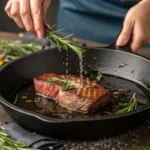
Denver Steak Recipe: Tips for Cooking It Like a Pro
- Total Time: 20 minutes
- Yield: 2 servings 1x
- Diet: Gluten Free
Description
Learn how to cook Denver steak like a pro! This step-by-step recipe includes tips for searing, seasoning, and serving this tender, flavorful cut of beef.
Ingredients
- 2 Denver steaks (1–1.5 inches thick)
- 2 teaspoons kosher salt
- 1 teaspoon freshly cracked black pepper
- 1 teaspoon garlic powder (optional)
- 1 tablespoon avocado oil (or any high-smoke-point oil)
- 2 tablespoons unsalted butter
- 2 fresh rosemary sprigs or thyme (optional)
- 2 garlic cloves, crushed (optional)
Instructions
- Prepare the Steaks:
Remove the steaks from the fridge 30 minutes before cooking to let them come to room temperature. Pat them dry with paper towels, then season generously with salt, pepper, and optional garlic powder. - Heat the Skillet or Grill:
Preheat a cast iron skillet over medium-high heat. Add the avocado oil and heat until it shimmers. If using a grill, brush the grates with oil and preheat to high. - Sear the Steaks:
Place the steaks in the hot skillet or on the grill. Let them cook undisturbed for 2-3 minutes per side to develop a golden crust. If desired, add rosemary, thyme, and garlic cloves during the last minute of searing for extra flavor. - Check for Doneness:
Use a meat thermometer to check the internal temperature. Aim for 130-135°F (medium-rare) or 140-145°F (medium). For thicker steaks, transfer them to a preheated 400°F oven to finish cooking. - Rest the Steaks:
Remove the steaks from heat and place them on a cutting board. Tent with foil and let them rest for 5-7 minutes to allow the juices to redistribute. - Slice and Serve:
Slice the steak against the grain into thin strips. Serve with roasted vegetables, mashed potatoes, or a salad. For extra flavor, drizzle with garlic butter or chimichurri sauce.
Notes
- Always use a meat thermometer to ensure the perfect doneness.
- Letting the steak rest is essential for retaining juices and tenderness.
- Customize the seasoning with your favorite spice blends for added variety.
- Prep Time: 10 minutes
- Cook Time: 10 minutes
- Category: Main Dish
- Method: Grilling or Pan-Searing
- Cuisine: American
Nutrition
- Serving Size: 6 ounces
- Calories: 380 kcal
- Sugar: 0 g
- Sodium: 850 mg
- Fat: 26 g
- Saturated Fat: 10 g
- Unsaturated Fat: 15 g
- Trans Fat: 0 g
- Carbohydrates: 0 g
- Fiber: 0 g
- Protein: 36 g
- Cholesterol: 110 mg
Keywords: Denver steak, steak recipe, cooking Denver steak, grilled Denver steak, pan-seared steak, tender beef recipe, keto steak, easy steak recipe

